It is never too young to make fitness a part of a child’s daily routine. Safety is key when training a child and there are different stages designed for people of all ages. It is imperative to create an appropriate program based around an individuals needs and age category. This is known as the Long Term Athlete Development Model.
Under this model training and goals are created for an individual depending on which developmental age range they fall under. Each age range is broken down into the following subcategories based on levels of intensity, maturity, and fundamentals that correlate accordingly with their age or how well they adapt to training:
Active Start – 0-6 years of age
o Learning the fundamentals of leading an active life
• Focus on developing brain functioning, coordination, social skills and motor functioning
o Fitness based around play
• Builds confidence, posture, balance, muscle, bone strength and enjoyment
o Should be part of everyday living and not forced
o Create a safe and challenging environment
Fundamentals – 6-9 for boys and 6-8 for girls
o Structured activities that develop basic skills
• Aim to create all around athletes not focusing on one sport
o Fun should be emphasized, slowly introducing competition
• Don’t focus on the score
o Build on fundamentals and motor skills
o Offer variety to encourage children to try multiple sports
o Encourage unstructured play
Learn to Train – 9-12 for boys and 8-11 for girls
o Educating on competition rather than winning
o Activities should be fun
o Begin more traditional training
• Use of body weight and non-heavy weights
o Focus on general sport skills suitable for numerous activities
Train to Train – 12-16 for males and 11-15 for females
o Specific skill training required
o Push them to do their best regardless of skill level
o Continue to develop skills
• Speed, strength, and flexibility
o Teach strategies to cope with the physical demands of sport and winning/losing
Train to compete – 16-23+ for males and 15-21+ for females
o Specific sport to specialize in
o Participate in recreation level sports for non-competitive athletes
o High intensity training and high volume can be initiated
o Assessing strengths and weaknesses
Train to Win – 19+ for males and 18+ for females
o Train for peak performance
o Training based around high volume and high intensity
o Institute prevention breaks to help avoid injuries and burnout
Active Living – Any age
o Building upon previous training experience based on motor skill development will allow the person to continue to be physically active
o Play multiple sports
o Participating in recreational activities
o Stay focused on fun!
Knowing when a person reaches their peak height velocity is vital when training a young athlete. Peak height velocity is when the maximum rate of growth in stature occurs during an athlete’s growth spurt. Typically for females this is around the ages of 12, for males this is approximately 14 years of age. These are estimates but it is important to know which stage of the developmental age range they are in to properly facilitate success.
Written by Rob Barriault




